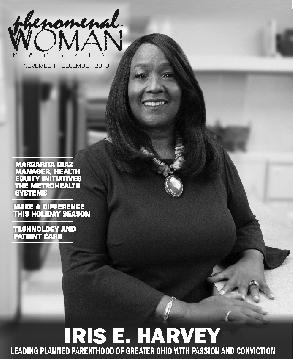

ANDREA FIELDS
phenomenal WOMAN Wphenomenal

Beletu (Belé) Wondwossen
Founder / Publisher
Shelley M. Shockley
Managing Editor
Writers
Shelley M. Shockley
Marsha Walker Eastwood
Brittany Garrett
Rhonda Crowder
Creative
Belé Wondwossen
Jason Garrett
Cover Story: Shelley M. Shockley
Photos: Jason Garrett
Contributing Writers
Rhonda Crowder
Michelle Phillips Fay
Marianna Marron
Letitia Nall
Stephanie Phelps
Kimberly Smith-Woodford
Advertising Sales
(Print)
2330-2550 (Online)












FromtheEditor: Shelley M. Shockley


EASE INTO FALL AND ITS BLESSINGS
As summer winds down and fall takes her place, I'm excited to see the possibilities awaiting me. Spring and summer were blurs for me, and I'm not sure how or why I languished through some of the best days of this year; however, I know it's time for a change.
Fall has always been my favorite season, a time ripe with nature's beauty shortened days filled with sunshine and brisk evenings calling for sweaters. It's a time to reflect on what you haven't accomplished, while planning how to finish some of the open-ended tasks on your list. This is where I tend to get stuck, because I'm not much of a planner.
Over the last five years or so I have worked on becoming a planner, understanding that many of the projects I haven't completed had one common denominator – no plan. When I am tasked with specific projects at work I create plans, but for the important things in my life I have been lax in creating a structured outline of how to accomplish the task.
With each passing day, I realize I'm closer to retirement and I haven't created a plan for what that will look like, so this fall my priority is to intentionally map out what retirement could look like and the steps to ensure my vision and reality are in sync.
Are you a planner or a doer? How has that impacted your life, and are you comfortable with your choice? I'd love to hear your thoughts on planning versus doing.
In this edition we highlight two women who created paths in unconventional careers – one out of a perceived necessity and the other following her passion. Here I'll offer a window into each feature to pique your curiosity. I hope you will take some time out of your day to meet Andrea Fields and Patrice Horton two phenomenal women making a name for themselves in male-dominated fields.
Andrea Fields has been fascinated with how things work her whole life. Her inquisitive spirit as a kindergarten student led to regular visits with the
school principal. You see, Andrea liked computers and believed she could help her classmates with their work. Instead of punishing her, her principal challenged her mind with math and science problems resulting in a young black girl falling in love with math and science.
Her love for two of the main components of STEM (Science, Technology, Engineering and Math) would lead her to Cleveland's MC2STEM High School as a member of the inaugural class. Her passion for the lessons and understanding of the concepts created opportunities to travel the world sharing Makers Spaces for generations to come. Her story is fascinating and highlights the importance of recognizing the genius that often resides in our youth.
Growing up surrounded by some of Cleveland's notable entertainers, Patrice Horton was no stranger to entrepreneurs and as a teenager developed a love for sports that would lead to her own entrepreneurial ventures. Her story is unique in that she isn't a female athlete but her love of sports and understanding of business afforded her the opportunity to represent NFL players, tennis stars and most recently WNBA stars.
Perseverance, tenacity and a mind for business and understanding people has propelled Horton's Patmon Consulting Group onto the big stage. Take some time to get to know Horton in this edition's feature profile.
In this edition, Columnist Marsha Walker Eastwood looks at the financial impact of choosing a STEM career path. Over the years, within the pages of this magazine we have highlighted the need for more women of all races to consider studying subjects within the STEM curriculum to effect more positive outcomes in communities, now Eastwood outlines how impactful that choice could be individually. If you're considering a career change or know someone entering the workforce, read this column and see how careers in STEM can benefit individuals and families.
As always, I pray we have provided interesting and engaging content for you. I look forward to meeting you back in this space soon!

PATRICE HORTON

Patrice Horton, a Cleveland native and the daughter of the legendary DJ Johnny O, has managed athletes since her early twenties. With her father in the music business, she worked with the likes of Gerald Levert in her teens but became interested in sports through her stepfather, who many know as the master hairstylist Kristofer Blu.
More on page 10 THE FUTURE PAY-OFF OF A STEM EDUCATION EASE INTO FALL AND ITS BLESSINGS

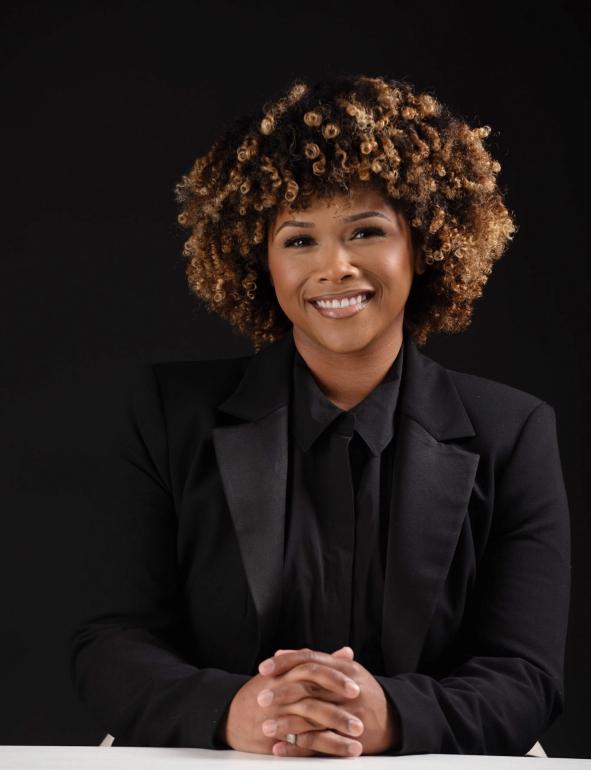
ANDREA
The active mind of a child is often silenced first by parents forcing them to sit down and be quiet, or later by teachers labeling them as bad, a nuisance, or in need of medication to calm them. This behavior stifles the innate brilliance of many children and leads them down a path of neglect, which causes them to act out everything the adults have said about them.
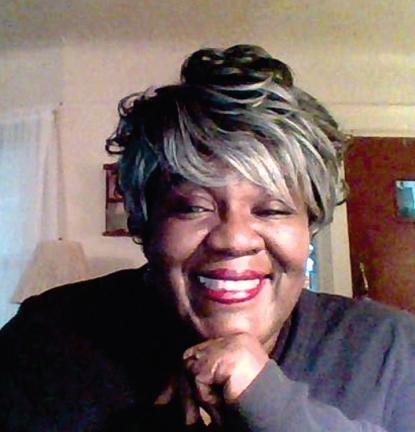
By: Marsha Walker Eastwood, BSEd, MSHSVC PWM Contributing Writer
THE FUTURE PAY-OFF OF A STEM EDUCATION
“An investment in knowledge pays the best interest." — Benjamin Franklin.
This quote from Benjamin Franklin highlights how education, a core value of STEM, is the most powerful investment you can make, with financial rewards as a significant byproduct. In today's rapidly evolving economy, education remains one of the most reliable investments in a person's future. Yet not all degrees offer the same financial returns. Over the past two decades, STEM (Science, Technology, Engineering, and Mathematics) fields have consistently ranked among the highest-paying and most stable career paths. From software engineering to biotechnology, the evidence suggests that a STEM education offers not only job security but also long-term financial rewards that can outpace those of many other disciplines.
My purpose here is to illustrate how a STEM education pays off, including salary trends, job growth, long-term earnings potential, and the broader economic impact of choosing a STEM pathway. One of the most immediate financial benefits of a STEM degree is the higher starting salary compared to non-STEM fields. According to data from the U.S. Bureau of Labor Statistics (BLS), STEM graduates often earn 20–30% more in their first job than graduates in the humanitiesor social sciences.
For example, computer science graduates frequently begin with salaries in the $70,000–$90,000 range, depending on location and company According to current economic forecasts, engineering graduates in fields such as petroleum, electrical, or mechanical engineering often earn over $65,000 immediately after college. By comparison, graduates in education, the arts, or social work may expect starting salaries of around $40,000 to $50,000. You can clearly see that STEM education sets individuals on a higher income trajectory from the very beginning of their careers.
While starting salaries are essential, lifetime earnings underscore the actual financial benefits of pursuing a STEM career. Research from Georgetown University's Center on Education and the Workforce shows that STEM majors can earn over $1 million more across their careers than non-STEM majors.
Several factors contribute to this, including a strong demand for technical expertise – Industries from
healthcare to finance now rely on STEM-trained professionals. Career progression opportunities –Engineers, data scientists, and IT specialists often advance into senior technical or managerial roles with sixfigure salaries. Additionally, industry flexibility should be taken into account. A STEM education provides transferable skills, enabling professionals to transition between sectors (e.g., a computer scientist can work in healthcare, entertainment, or government). In short, STEM graduates not only start strong but also maintain earning power well into their peak working years. One of the more significant benefits of a STEM education is job securityand stability
While high pay is attractive, another financial advantage of a STEM degree is job security. Automation and globalization have threatened many industries, yet STEM jobs have largely shown resilience. The BLS projects that STEM occupations will grow nearly twice as fast as nonSTEM occupations over the next decade. Fields like cybersecurity, renewable energy engineering, and biotechnology are expanding at record speeds. This matters financially because stable employment reduces the likelihood of long periods without income. Professionals in high-demand STEM sectors often have leverage to negotiate higher salaries and better benefits. Even during economic downturns, STEM jobs particularly in healthcare,IT, and infrastructure—remainessential.
This stability translates into more consistent income and better long-term financialplanning opportunities.
While a bachelor's degree in STEM already provides a strong financial return on investment, pursuing advanced degrees can increase earnings even further For instance, A master's degree in data science can push salaries beyond $120,000 annually; A PhD in engineering or physics often opens doors to high-paying research or specialized industry roles. Healthcare professionals—such as physicians and pharmacists combine STEM foundations with advanced degrees to achieve some of the highest incomes in the labor market. In contrast, advanced degrees in non-STEM fields sometimes fail to deliver significant salary boosts, making STEM a more financially rewarding investment at both the undergraduate and graduate levels.
Another consideration is that STEM graduates are uniquely positioned to tap into entrepreneurial ventures that can multiply financial rewards. Individuals with a strong STEM background often find success in startups within the technology, biotech, and engineering sectors.

Some examples of these include tech entrepreneurs who create software solutions or mobile apps, biomedical innovators who develop new medical devices or therapies, and green energy engineers who design sustainable solutions for climate change. Because STEM knowledge is closely tied to innovation and problem-solving, graduates often find opportunities to create businesses, attract investors, and generate wealth on a scale that exceeds traditionalemployment.
The financial rewards of a STEM education can vary by location and industry, but the advantages remain consistent. In Silicon Valley, software engineers often command salaries exceeding $150,000, reflecting the demand in tech hubs.
In the energy sector, petroleum engineers can surpass $130,000 annually, particularly in states like Texas. In biotechnology hubs like Boston, STEM professionals in medical research and pharmaceuticals are among the top earners.
Even outside major hubs, STEM salaries tend to remain above the national average, ensuring financial benefits regardless of geography
While direct salary is the most obvious financial reward, several indirect benefits of STEM careers contribute to the equation. Comprehensive benefits packages are often included in STEM roles, which may consist of stock options, bonuses, retirement contributions, and health insurance, thereby reducing out-of-pocket expenses and helping to build long-term wealth. Remote work flexibility: Many tech-related roles offer remote or hybrid work arrangements, allowing employees to save money on
commuting, relocation, and childcare expenses
Professional development opportunities: Employers in STEM fields often invest in ongoing training, certifications, and education, thereby further enhancing earning potential at minimal cost to the employee. These perks not only increase disposable income but also improve longterm financialsecurity
When it comes to weighing the ROI of a STEM education, a valid concern is that STEM degrees often come with higher upfront costs due to lab fees, equipment, and longer program durations (in some cases). However, when measured against long-term financial rewards, the return on investment (ROI) remains among the highest of any field. Consider this: a STEM graduate with $40,000 in student debt may still out-earn a non-STEM graduate with no debt within 3–5 years of employment. Over the course of a lifetime, the higher salaries of STEM graduates far outweigh the initial costs of their education. Thus, while upfront costs are higher, the payoff is significantly more substantial.
Examining STEM wealth generation across demographics reveals a crucial point: the role STEM plays in reducing income disparities. Women and minorities entering STEM fields often experience a smaller gender and racial pay gap compared to non-STEM careers. For instance, women in STEM earn, on average, 33% more than women in nonSTEM occupations. Minority STEM professionals often command salaries significantly above national averages for their demographic groups. This means that STEM education not only benefits individuals but also contributes to broader financialequityin society.
Continued on next page...
GET THE BAG.
ARE YOU A BLACK WOMAN ENTREPRENEUR SEEKING TO ...
■ Grow your business to $1Million+.
■ Transition from side-hustler to CEO.
■ Be inspired by and learn from a community of BOSSES.
■ Easily access info about small business grants, funding and business opportunities.
■ Gain insider tips and information about business funding options.
■ Succeed in business AND be inspired to practice self-care.
■ Discover Black women-owned and socially responsible brands.
■ Meet authentic champions of Black womenowned businesses who want you to succeed.
■ Have fun!
LOOK NO FURTHER, VISIT US @ www.getthebag.biz /or/ info@getthebag.biz


When discussing the positives of a STEM education, the financial rewards of STEM are not confined to one country. STEM professionals are in high demand globally, enabling them to pursue international mobility and earn competitive salaries abroad. Some examples include engineers, who are heavily recruited in the Middle East, often with tax-free wages and housing allowances; software developers and AI specialists are sought after across Europe and Asia. Biotech researchers are globally mobile, moving between academic and private-sector opportunities.
This global demand ensures that STEM graduates can maximize their financial potential beyond their home country, a flexibility that many other professions do not offer
Looking ahead, the financial benefits of a STEM education are poised to grow even further as emerging technologies continue to reshape the global economy Artificial intelligence, quantum computing, robotics, and renewable energy are not only creating new industries but also redefining existing ones. Professionals trained in STEM will find themselves at the forefront of these transformations, enjoying premium salaries as businesses compete for scarce expertise Moreover, governments and corporations worldwide are investing heavily in STEM initiatives, offering scholarships, research grants, and funding programs to encourage more graduates to pursue careers in these fields. This support reduces educational costs and increases the ROI for students choosing STEM pathways. In short, as technology continues to drive innovation, the gap between the financial rewards of STEM and other fields is likely to widen, ensuring that those who invest in STEM education remain among the top earners of the 21st century
As a future-proof investment, the evidence is overwhelming: a STEM education offers some of the most substantial financial rewards available in today's economy From higher starting salaries to long-term earning potential, job security, entrepreneurial opportunities, and global demand, STEM degrees consistently outperform many other disciplinesin terms of financialreturn.
While no degree guarantees wealth, STEM provides the closest thing to a future-proof investment in education. For students considering their academic and professional futures, the financial case for STEM is compelling: not only will it open doors to stable, fulfilling careers, but it will also ensure that the investment of time and money in education pays dividends for decades to come. g

LOCAL WOMAN FINDS ENTREPRENEURIAL NICHE IN FEMALE ELITE SPORTS PATRICE HORTON
By Rhonda Crowder PWM Contributing Writer
According to an article on Forbes.com last year, women's elite sports were poised to generate over $1 billion in global revenue for the first time in 2024, driven by surging interest.
In the same year, the Women's Basketball Championship game drew 18.9 million viewers, surpassing the men's tournament. The 2023 Women's World Cup final attracted 13.21 million viewers in the UK alone. And, the year-on-year growth in viewership suggests the surface of its potential is just being scratched.
Additionally, the WNBA will be returning to Cleveland in 2028!
The rapid development of new leagues has made investing in women's sports increasingly more attractive and full of opportunities. Now, more than ever, women's sports are on investors' radars, with their status as one of the fastest-growing industries making the market especially enticing. Overall women's sports are increasingly profitable, as seen with the 2023 Women's
World Cup which exemplifies this success, generating over $570 million in revenue and breaking stigmas around women in sports.
And, at the same time, one local female is carving out a major off-the-court entrepreneurial niche for herself in women's sports.
Meet Patrice Horton
Patrice Horton, a Cleveland native and the daughter of the legendary DJ Johnny O, has managed athletes since her early twenties. With her father in the music business, she worked with the likes of Gerald Levert in her teens but became interested in sports through her stepfather, who many know as the master hairstylist Kristofer Blu.
“I wasn't an athlete but I knew I wanted to do something in sports,” said Horton during a phone interview. “I just didn't know what.”
With a friend, she started her first business Tuff Luv, and represented former NFL player Donte Whitner. While working with Whitner, she learned everything about the business including the heartaches and pains.

“I even help them think through decisions about getting married and starting a family and how they prepare for life and career changes,” said Horton, whose job doesn't stop at the end of the workday. She often finds herself like a parent, up late, worrying, and making sure the clients made it home safely.
“I talk to them several times a day,” she added before noting the difference between managing male and female athletes.
“It is a challenge working with women. Women can carry much more than men but, being older now, I can be that big sister, auntie, mentor to younger women.”
Horton said the biggest challenge for females working in the sports industry is the lack of respect from others. “We are the ones putting the fires out and fixing things, but the last to be acknowledged.” And, Black women, she said, are really put last.
She also said women who represent male athletes are often initially perceived as a “love interest” as opposed to their actual manager. However, the rewards outweigh the challenges as she enjoys providing structure for her clients when they lack it, nurturing them, managing them, and educating them so they can perform.
“I love when they say, 'I'm so happy I don't have to worry about [fill in the blank],'” said Horton. “I love fighting for them and making sure their voices are heard.”
Additionally, she loves the “essence of the deal,” producing behind the scenes.
When asked about opportunities for women in sports, overall, Horton said, “We own this space. There is a female behind every door in sports. Females are making it happen and we can't be afraid to own this space.”
As far as opportunities for entrepreneurial opportunities for females in sports, Horton believes that's something one would have to make happen for themselves. Gaining her clients through word of mouth, she understands that her business stems from the relationships she's cultivated over the years and, without them, she's nothing.
“Character is what carries you,” she said. “If your character can't sustain you, you won't make it. I'm proud of Patmon Consulting Group because I launched it myself. It puts a different pressure on me as I seek to build a legacy beyond my years.”
Introducing A BRAND NEW High School Experience
Opening Up in East Cleveland, OH for the 2025-2026 School Year!
Welcome to North Shore High School!

North Shore High Schools are conveniently located in East Cleveland, Cleveland, and Garfield Heights, Ohio.
Our school helps students earn an accredited high school diploma fast! With College and Career Fast-Track Graduation Pathways, North Shore will open the door to your future.
Here's the GREAT news: Our High School, Career, and College courses are 100% FREE. Our 2025-2026 Application is available now
Seats are filling up Fast! Enroll Online Now and get on the North Shore Fast Track to Your High School Diploma!
WHY CHOOSE OUR HIGH SCHOOL?
§ Flexible and Relaxed Learning Spaces: Our classrooms are designed to foster comfort and focus, making it easier for students to learn at their own pace.
§ After-School Activities: From clubs to job trade, we offer a variety of activities to keep students engaged beyond the classroom.
§ Mentoring and College/Career Support: We are committed to guiding students toward their future goals, whether that means college, vocational training, or entering the workforce.
§ Accredited Curriculum: Earn your diploma with confidence, knowing it is recognized and respected.
Principal LaTasha K. Goodall, a proud native of East Cleveland, is dedicated to creating an educational experience that uplifts and empowers our students.
Enroll now for the upcoming 2025-2026 School Year at www.nshighschool.com and choose the East Cleveland Campus!
Let's begin your students' future with us today! 100% FREE WALK-INS WELCOME! 10AM - 2:00PM, MONDAY — FRIDAY

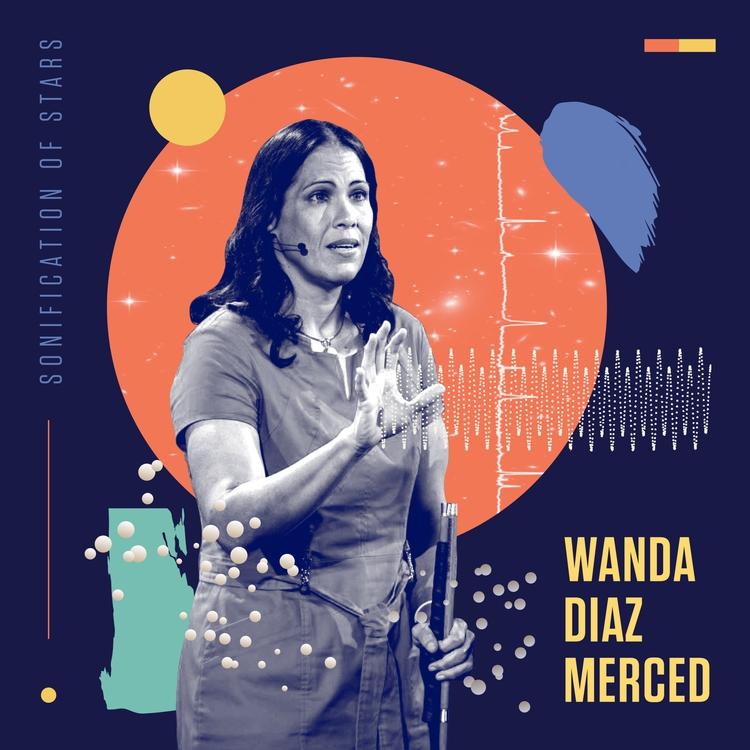
Wanda Díaz Merced is a Puerto-Rican astronomer best known for using sonification to turn large data sets into audible sound. She currently works at the South African observatory's Office of Astronomy for Development leading the project AstroSense.
When Wanda Díaz Merced lost her sight in her early 20s, her dreams of studying stars in the visually oriented scientific world suffered a major setback -until she discovered “sonification,” a way to turn huge data sets into audible sound using pitch, duration and
other properties. Merced realized that she could use her ears to detect patterns in stellar radio data, and could uncover connections obscured by graphs and visual representation.
While working at the Harvard-Smithsonian Center for Astrophysics, Merced's sonifications inspired musician and researcher Gerhard Sonnert to create X-Ray Hydra, an album of oddly jazzy music based on her audio representations.
EUCLID NATIVE RETURNS HOME TO OHIO FOR COLUMBUS NAVY WEEK
By Ashley Craig, Navy Office of Community Outreach
MILLINGTON, Tenn. – U.S. Navy sailors from across the fleet are headed to Ohio for Columbus Navy Week, Aug. 18 to 24, to volunteer in the community and discuss why the Navy matters to the heart of the Buckeye State.
While many of the sailors are from all over the country, this Navy Week will carry special meaning for visiting sailors from the state, including Lt. Cmdr. Nicole Kelly-Moore, a native of Euclid, Ohio.
Kelly-Moore was born in Cleveland and moved to Euclid as a child, graduating from Euclid High School in 2005. Kelly-Moore continued studies in Ohio, earning a bachelor's degree in applied health science from Bowling Green State University in 2009 and a bachelor's degree in nursing from Ursuline College in 2012. Upon joining the Navy, Kelly-Moore quickly found that many of the skills and values forged in Euclid were the same as those needed to succeed in the Navy.
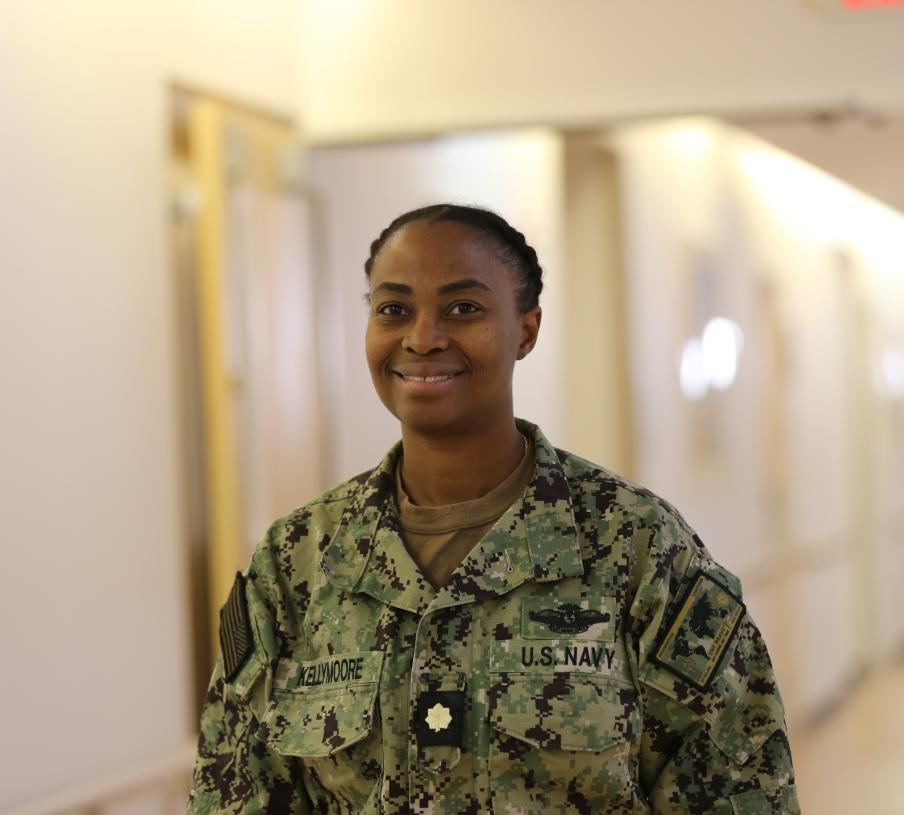
Kelly-Moore said. “It affords me a chance to say 'thank you' in a tangible way.”
Today, Kelly-Moore is a member of the Navy Nurse Corps and serves as both the director of medical services at Navy Medical and Readiness Training Command Lemoore and the officer in charge at EMF Bravo Det. Lemoore.
“I think one of the things that has stuck with me is to try to see a situation from all angles and not just the viewpoint of one single source,” Kelly-Moore said. “This has taught me to see scenarios from the paradigm or perspective of others. This idea was taught to me by a teacher who challenged the class to see the holistic picture and not just through our narrow lenses.”
Kelly-Moore, who joined the Navy 15 years ago, is assigned to Expeditionary Medical Facility (EMF) Bravo, Detachment Lemoore at Naval Air Station Lemoore, California.
“I was in Navy Junior ROTC in high school and this opportunity exposed me to military culture,” Kelly-Moore said. “Additionally, my mother was previously in the Army. Serving in the military has afforded me an avenue to serve my country while helping others within the United States and abroad. I have had the unique privilege of meeting a large, diverse group of people that has positively impacted me personally and professionally.”
Kelly-Moore is part of the first Navy Week to be hosted almost entirely in Columbus. Navy Weeks are a series of outreach events coordinated by the Navy Office of Community Outreach (NAVCO) designed to give Americans an opportunity to learn about the Navy, its people, and its importance to national security and prosperity.
“Participating in this Navy Week is important to me because it provides me an opportunity to give back to and directly interact with the communities that directly contributed to my success and who I am as a person,”
“I ensure that the clinic where I work provides safe, reliable care to the people we serve daily,” Kelly-Moore said. “Also, I ensure that my sailors are always ready clinically, physically and emotionally to deploy at short notice across the globe.”
Kelly-Moore has had many opportunities to excel in the Navy and sees military service as more than just a job –it represents a chance to become a better person and make a difference in the lives of others.
“I am most proud of being Meritoriously Redistributed when I was selected to lieutenant commander,” KellyMoore said. “My selection was moved up to near the top of the list of all lieutenant commanders selected. Additionally, I am always most proud when I am asked to be a sailor's reenlisting officer because it is such a great honor.”
Kelly-Moore is grateful for the Euclid community and for those who helped make a Navy career possible.
“I would like to thank my whole family, including my mom, my dad, my sister, my brother and my nieces and nephews,” added Kelly-Moore. “I want to thank my daughter, Sierra, who has been an integral part of my success story. Finally, I would also like to thank all the amazing teachers I had growing up ”
Since 2005, the Navy Week program has served as the Navy's flagship outreach effort into areas of the country without a significant Navy presence, providing the public a firsthand look at why the Navy matters to cities like Columbus.
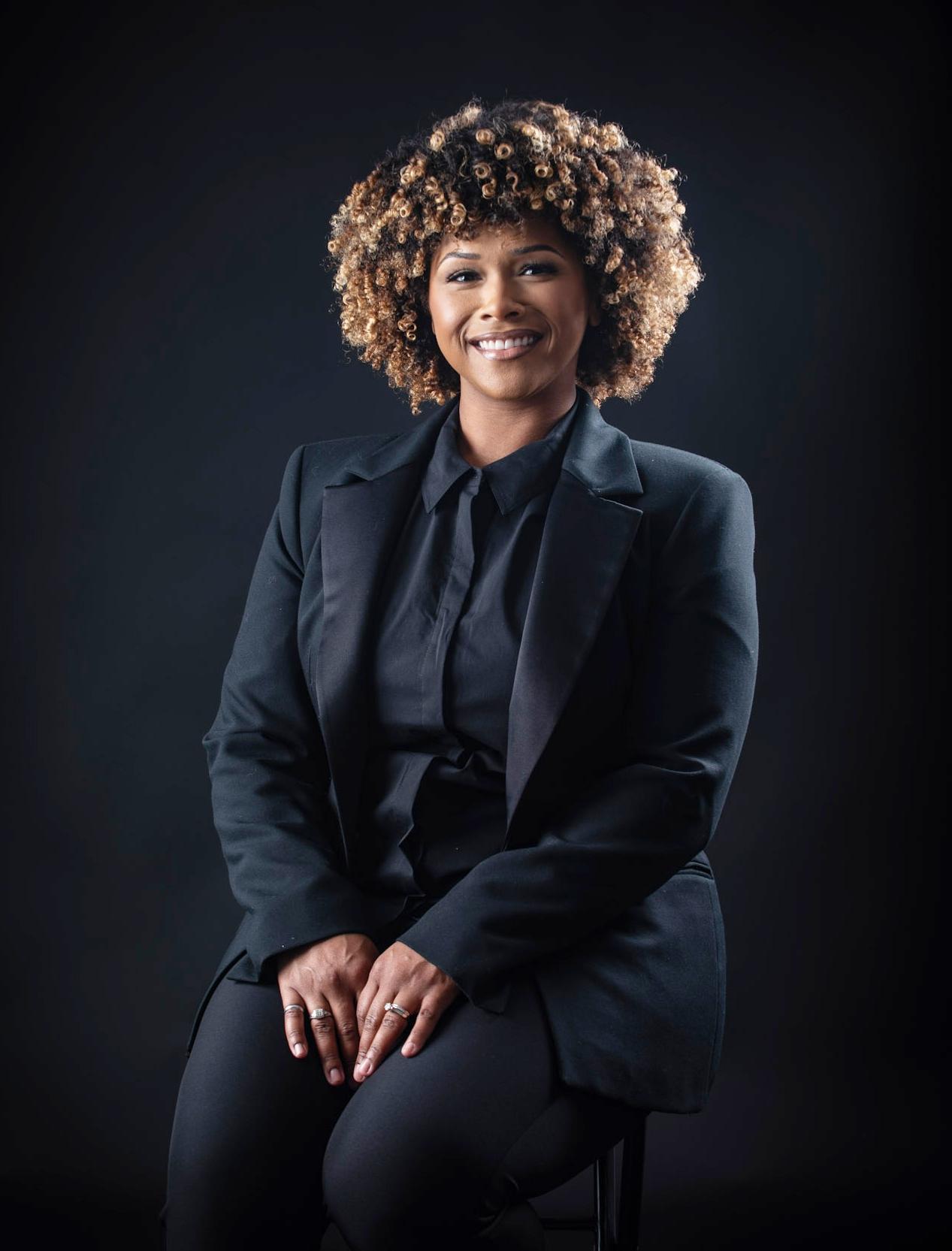
PHOTOS: JASON GARRETT THE BLUSH GALLERY
FROM FAB LABS TO GAS LINES, ANDREA FIELDS IS CREATING A SPACE FOR WOMEN IN STEM
Shelley M. Shockley PWM Managing Editor
The active mind of a child is often silenced first by parents forcing them to sit down and be quiet, or later by teachers labeling them as bad, a nuisance, or in need of medication to calm them. This behavior stifles the innate brilliance of many children and leads them down a path of neglect, which causes them to act out everything the adults have said about them.
History tells us, “the mind is not a vessel to be filled but a fire to be kindled.” These are the words of the Greek writer and biographer Plutarch. Similarly, the late Jess Sinclair said, “Children are not things to be molded but are people to be unfolded.”
Andrea Fields, Gas Operations Supervisor for Enbridge Gas in Cleveland, was fortunate to be surrounded by adults who knowingly or unknowingly followed the teachings of Plutarch and Sinclair
At the tender age of five, Andrea was full of energy and intrigued by technology. She did not know how computers, remote controls, or other gadgets around the house worked, but she knew she wanted to figure it out. These tools represented a puzzle, and she wanted to take them apart and use her imagination to put the pieces back together
As the youngest of six growing up on Cleveland's southeast side, her father's energy matched hers as he, too, was good with technology, while her mother was the creative spirit in the home. Andrea's thirst to solve problems and learn would eventually be one of her strongest assets, but in kindergarten, this curiosity led to the principal's office.
Remembering that time, Andrea said, “Funny story. It's funny now, but traumatic back in kindergarten. I would get kicked out of class every day for helping other kids on the computer because I loved them, and I was always good with them.”
Her fascination with technology may have been in her DNA, but it wasn't from lessons. She said, “It just came naturally to me. Games, anything technology-based - I love problem-solving and figuring things out. I would break my brother's game controller and try and figure it out. Most of the time it wouldn't work, because I didn't know what I was doing.”
Visiting the principal's office was an extended classroom instead of punishment. Seeing something special in Andrea, her principal used this time to have her young student complete math and science problems. Andrea said this unique form of punishment helped her “fall in love with math and science.”
After elementary school, Fields was anxiously preparing to go to Gracemount because the school had advanced placement programs, only to learn that she was too advanced and instead would be attending Whitney Young Magnet School. Her reputation preceded her, and everyone knew she was a techie, so when a Focus Group was formed to recruit students for the new high schools, Cleveland Municipal School District (CMSD) was developing.
In the early 2000s, CMSD, along with other districts around the country, was investigating and developing new school formats to engage young people and prepare them for college and careers. The Focus Group Andrea participated in was an opportunity to gauge the interest and likelihood of students successfully enrolling and completing the programs.
Her instructors recognized she had a high aptitude for math and science and placed her in the group for MC2STEM, a planned year-round high school focusing on STEM education (science, technology, engineering, and math).
“ ”
Ultimately you build your relationships off of how much you value yourself. If you don't value yourself, you're gonna accept anything.
The school was developed as a partnership. MC2 STEM was founded in 2008 as a public-private partnership involving the Cleveland Metropolitan School District (CMSD) and several key organizations in the Cleveland area. It was designed as a project-based learning environment exposing students to the design and implementation practices scientists and engineers use.
Initially, the key drawback for Fields was year-round school, and while she is gifted, she is also outspoken and recalls saying, “I'm not going to school in the summer” Despite her hesitancy, she participated in the group, understanding that she had a larger problem at home.
Her parents announced that after raising and educating her five siblings in the Cleveland Municipal Schools, they wanted to send her to a boarding school to get the best education possible. Her response to that was, “You're not shipping me away for school.”
Continued on next page ...

The headstrong middle schooler began to embrace the idea of year-round school and enrolled herself in MC2STEM without her parents' knowledge. The ruse began with her parents dropping her off for what they thought was a summer camp, but was orientation for high school. Fields said, “I fell in love with the school and told my parents I'm going to this high school in Cleveland.” They were shocked, but she sold them on the idea by explaining it was a STEM school and would provide her with a wealth of opportunities.
The joy of learning in a unique situation is evident as Andrea explains her high school experience. She also appreciates the support she received from her teachers throughout her experience as a CMSD student, stating, “I knew I liked math and science, and STEM had those two things, so I thought I would give MC2 a shot. My teachers along the way saw things in me and at first didn't know where to put me, but they didn't stifle me either.”
She quickly learned that MC2STEM was a unique place. The year-round school year didn't mean attending classes during the summer; there were internships and other opportunities for the students to continue to strengthen their minds and problem solve.
As a member of the inaugural class, Andrea was afforded great opportunities that would propel her into places and spaces she never dreamed of. As she explained the philosophy of the school and the learning style, she mentioned MIT (Massachusetts Institute of Technology) as a guiding force.
Explaining the connection, she said, “MC Squared had a Fab Lab, today called a Makerspace, or in libraries called Innovation Centers. You have laser cutters, 3D printers, vinyl cutters - all these tools in a space to give you the capabilities of making almost anything.” The idea was founded out of MIT's Center for Bits & Atoms in a class they have called “Make Almost Anything.”
Realizing the capabilities of labs like this on a global scale, MIT partnered with developing countries and
brought the technology to them. Recognizing the importance of programs like this, MC2STEM founders and nonprofits sought to add this component to the high school. The MIT professor who created the class initially declined, saying it was for the college and third-world countries. The game changer was that a community college and the high school already had a form of the lab. Andrea explained, “The lab was embedded in our curriculum as a part of the day-to-day. We had the lab in the school and we made a lot of projects. We didn't take a lot of tests, but it proved to be very beneficial for the students.”
MIT eventually came aboard, she said, and helped install the MC2STEM lab with the help of the high school students. This partnership blossomed during her sophomore year and would lead to greater opportunities. MIT annually hosts an international conference for all of the labs it helps develop to convene and discuss the work they have done.
When she was a junior in high school, MC2STEM was invited to attend the conference to showcase and discuss the labs on a high school level. The conference was held in Lima, Peru, and Andrea was chosen to attend. “I went with my art teacher, who then became my assistant principal, and flew to Lima, which was my first time out of the country, to represent the work we were doing inside education for the labs.”
Of the high school training she received, she said, “It taught you how to think, not what to think. That's why I was so adaptable to all the different places.”
One of the unique spaces she found herself in was serving as the Fab Lab Technologies Director. In this position, she had the opportunity to teach, or as she prefers, instruct teachers on how to teach in the Fab Lab environment. While from the outside someone may see her teaching teachers, she said, “I think of myself as more of an instructor because of the value I place on teachers and the impact they had on my life. I commend them.”
Offering a demonstration of her approach to instructing, she said, “It's like a framework. What you fill that building with is up to you, and the level or quality of the result is based on the level of effort you put into it. So, being able to give you the basics of whatever the topic is. Let's say we are trying to figure out how to build a house. And I say, okay, it has to be this big and it has to have this number of rooms, and that's your only limitations.
She continued, “What will you build from that? And to start, it's like a lot of failure. But to turn that failure into results is the change of the mindset. What I developed out of it was that there's no such thing as failure, only learning – because you have to learn what didn't work, so that way you can fix it, or maybe it didn't work in a way that proved to be a benefit in another area.”
She said working with teachers was interesting because they have a mindset of teaching three things in order: “I have to teach these things in this order. You're not going to get to C without going to A and B, but the Fab Lab gives you the chance to create DEF without ever seeing A or B because of the need that you have, so that mindshift was hard.
Andrea used her high school years to not only learn in the classroom, but also in the world. Every summer, she worked at Rockwell Automation, which was a good experience, but she figured out she didn't want to follow that path. The training program canceled out teaching as a profession, but along the way, she learned, “I'm good with connecting dots for people and being the middleman.”
After high school graduation, she needed to pay for college and didn't want to take out loans, so she continued to work at the Fab Lab and attended Lorain Community College for two years, helping them build their lab. Proud of the work she did in Lorain, she said, “Their lab is extremely successful. It's one of the highlight programs for makerspaces and fab labs.”
This plan worked well for Fields, attending school, getting all of the prerequisites she needed for a degree in engineering, and at the same time building out their lab. She would carry this pattern to Cleveland State to complete her degree while working on the MC2STEM lab and traveling as a consultant to set up labs all over the country.
With her innate skill and passion for STEM she was often asked why she didn't enter an Ivy League school, where she was destined to succeed. The answer lies in her key personality trait of independence. Her response was, “I could have done that, but then I wouldn't have had these other opportunities to teach around world.” As she did throughout her educational career, Fields encountered supportive professors who provided her with the leniency she needed to work and learn. She said, “My professors allowed me to miss two weeks of school every two weeks because I was traveling to Boston to set-up GE's lab. They had trailers that they put the lab in, so I was in their communities for their schools helping to win their school districts over to get it implemented for them.”
Not all of her professors were on board, but when she repeatedly made the Dean's List at the end of the semesters, the naysayers joined the ranks and allowed her to do what she needed in order to study and pay for her education.
Not only did she have a strong independent streak she said her experience in Peru “changed my view of the world. People don't have access to the things that we have and we take advantage of things. So, my time - I wanted to be able to spend time developing myself, so I could have an impact on other people's lives, whatever that may be.”
During this time Andrea was also balancing the life of a wife and mother, but with the support of her professors and clients she was able to receive her degree and make an impact before the world shut down with the Pandemic.
The Pandemic became another opportunity for her to pivot into utilizing her skills to have an impact on the community - creating PPE for people working in the lab. She created face shields and door openers for the community.
As Fields worked on developing her own collegiate and career path she didn't experience many of the usual challenges for a young black woman in a male-dominated field until the world changed with Covid. Just as Covid hit she was preparing to move to Los Angeles, but with the pandemic, the jobs pulled away and she had to restart her career. She realized the education route wasn't going to pay her bills so she entered the corporate world.
Making this shift, also shifted the climate on the job. She said, “When I went corporate that's when the reality hit that people really don't like black women in engineering, and civil engineering is like a subset of and already male field of engineering.” To illustrate she said, “I graduated in civil engineering, four other females and I was the only black.”
With numbers like that she said, “I had nobody to look at. But again, I'm trained at this point to not have anybody to look at as far as how to navigate it. So once I got into corporate America and my boss, ignored my input I tried to deal with it at first.” She said the treatment as blatant and as an example she offered, “If I said dog is blue. He would say, “Oh my gosh that dog is blue.” I would have literally said the same thing two seconds before. She said in meetings her ideas were not being heard. The mistreatment burned because she felt like the secretary of the group despite she had a master's in engineering and everyone else had BA's.
The inequity in pay was also glaring, she said she was being paid at the level of an intern and when asked others what they were paid it was more than double. The mistreatment was too much and Andrea said, “I always said I never went to work saying I hated my job. I hated this job. I hate engineering, I should have gone to culinary school.” She was told her wages would increase after three months, and she thought okay maybe I should humble myself because this is my first engineering job.
All of the affirming talks didn't help after three months she left and went back to consulting, swearing off corporate work. Her commitment to a career in engineering and a recommendation from a friend would bring Andrea back to corporate engineering. A friend suggested she look into design work at Dominion Energy, and her initial response was “I can't do corporate American again.” Her friend said Dominion was different.
The position was to design gas lines with extremely low pay, but Andrea believed, “I need to commit to the corporate world for a little bit to be able to restart my career in this field.” The reentry to corporate proved to be similar but this time her colleagues looked at her as a spy because she was overqualified for the position.
Continued on next page ...
Attempts at being happy with the position and accepting advice, code switching and trying to fit in with her all male team didn't work. She explained the resistance she received was not from her work, but based on personality. She refused to be confrontational even when the programs she needed weren't added to her computer, her problem solving was questioned yet she remained pleasant.
She continued, "So that is when I left and decided to look into the management side of the business.. But the closer I got to being more technical in my field, the more pushback I got for being kind. And I was like, how can me being kind hold me back as an engineer?”
At this point she decided to switch to the business side of engineering, just as the company was sold to Enbridge Gas. The change in ownership included a change in culture. She explained, “They have a completely different view on the technical side and leadership. They are more blended. So you can still do the technical route and be closer to the pipe and design and still be able to get all the way up, let's say, to a director, if that's your goal. And they also have a more diverse working group ”
Enbridge also has a more diverse workforce. Andrea's director is a black male who has been with the company for over 30 years and a female black manager. This diversity flows throughout the organization from IT to designers.
In her current role she said, “I'm a lot happier. Well, I wasn't unhappy, but I have that light back of I really like my job. I really like the company I'm working for. They are pushing for the development of the team. For example, there's a director not in my group at all, but he would see opportunity, like, hey, you should go apply for this. I think you'll be a nice fit for the program. And I'm like, okay.” The development includes supporting Andrea as she works to get her MBA which she said shows, “They're aligned with you as a whole versus just a number, checking the box for diversity.”
As the gas operations supervisor, Andrea overseas a team that surveys all of the gas lines in Ohio. To best explain the work she does she used a new home build has an example. To begin she said, “Hopefully there's a main line near you. If not, then we have to build a main line and then we give you the service off of it. So when you do that, you have to connect with all the other utilities to make sure when we don't hit your line or hit the other utility and that it's a certain distance away from your house and it's within an easement.”
She continued, “If we have an easement or it's in a sidewalk or sometimes it's just in a road, depending on the county, but you work in basically in Google Earth, let's just say, find out the best travel or the easiest travel for the gas to that home. And then we design literally where the line goes in the grass, well in the ground.”
Ideally, the line would be exactly where it was designed, but she said sometimes contractors may deviate a little, “so it's a little curved, but we try to get it as close as we can, designing it to consider safety.”
To help with the detection of leaks, the gas companies odorize the gas in their systems with an odorant unique to each company. She explained that sometimes reports of a smell are a result of a variety of things such as animals, or even over odorizing the lines and not a gas
leak. To remain safe she said, “If you smell something small or big we treat it the same - let's figure it out and let's be as safe as possible.” Safety is key in line design as well as identifying leaks. She advised, “If you call in a gas odor, don't touch anything, just leave so the gas company can identify the source.”
A great deal of Andrea's job requires her team to walk communities and checking the lines are safe. She attempted to clear up some myths about gas and explosions. If a space is filled with natural gas and you light a match it won't necessarily cause an explosion. The explosion, she explained,”It has to be that sweet spot of amount of gas to oxygen in the space to cause an explosion.”
When she isn't walking gas lines with her team or walking the design of gas lines, you can find Andrea working on her nonprofit, the LYF Foundation which is the acronym for Love Yourself First. The foundation is an outgrowth of a traumatic situation she experienced in high school. She said, “I was in a relationship and this was along the time when things started going viral, and the guy I was with beat me up pretty bad and it was on camera and it became a meme or like a funny video to people when he fainted in court. I went through an extremely dark time and I'm like, I can't get out of whatever my mindset this was.”
To find relief she said, “I went back to my high school looked at all the projects that I made and I remembered exactly how I was feeling and what I was doing, my mindset and all those spaces.” That recognition of the good in her life prompted her to want to give that same opportunity to others. Her safe space was the lab and creating but for someone else she said it might be painting a picture, maybe it's listening to music, maybe it's going on a walk and literally being one with your senses. It's an opportunity to be “present in the moment for yourself to figure out what works for you.”
The foundation was created with high school girls in mind, because they might be like she was holding in the bad and not sharing with someone to help. The LYF Foundation is that place and it incorporates STEM. A major goal of the different programming is being present in the moment for yourself to figure out what works for you.
One of the STEM programs is a six-week classroom session on Saturdays where they build and create, but they also journal and unpack their feelings. She works with the UH Health and Wellness Center for the wellness portion of the day and she oversees the STEM programming.
Her philosophy is to provide more tools for people to recognize themselves, what they are going to tolerate and what they are not willing to accept because, “Ultimately you build your relationships off of how much you value yourself. If you don't value yourself, you're gonna accept anything. But as you build those tools to recognize where you are and who you are, hopefully you will not tolerate so many different things or recognize it sooner to get out quicker.”
When Andrea isn't overseeing the design of gas lines or working with young people she is wife, and mother to three children. She enjoys spending time with her family and attending the City of Joy Church in Akron, Ohio where her family worships. g
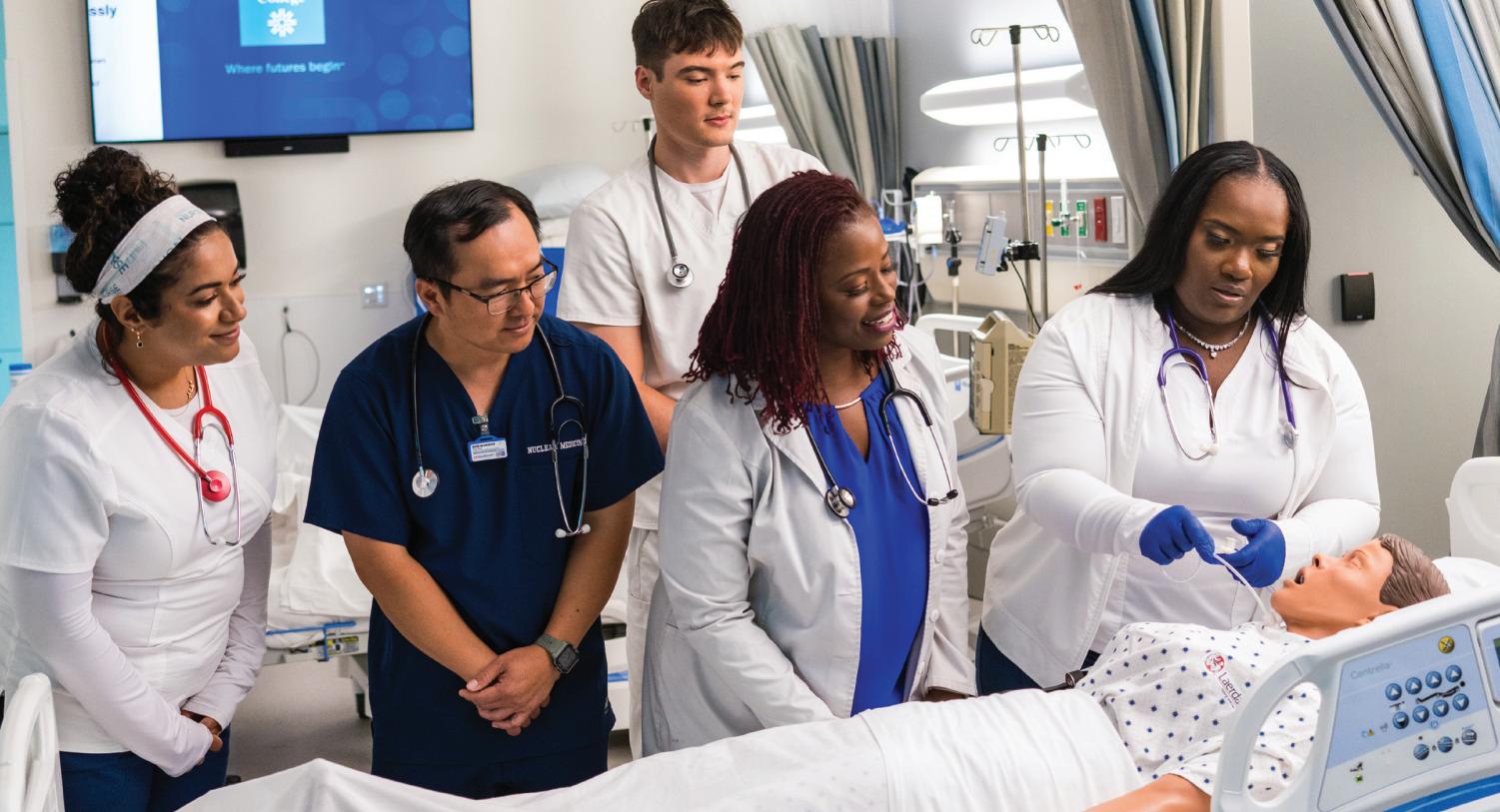









As a small child Farida Bedwei was diagnosed with cerebral palsy, an incurable neurological disorder that affects body movement and muscle coordination. Overcoming many challenges, she became a skilled software engineer. Today, as the cofounder and chief technical officer of software company Logiciel, she is considered one of the most powerful women in financial technology on
the continent. In 2013, South Africa’s CEO Magazine named Bedwei the most influential woman in business and government in Africa for the financial sector
She considers her most significant achievement to be the development of a cloud software platform that is being used by 130 microfinance companies in her native Ghana.
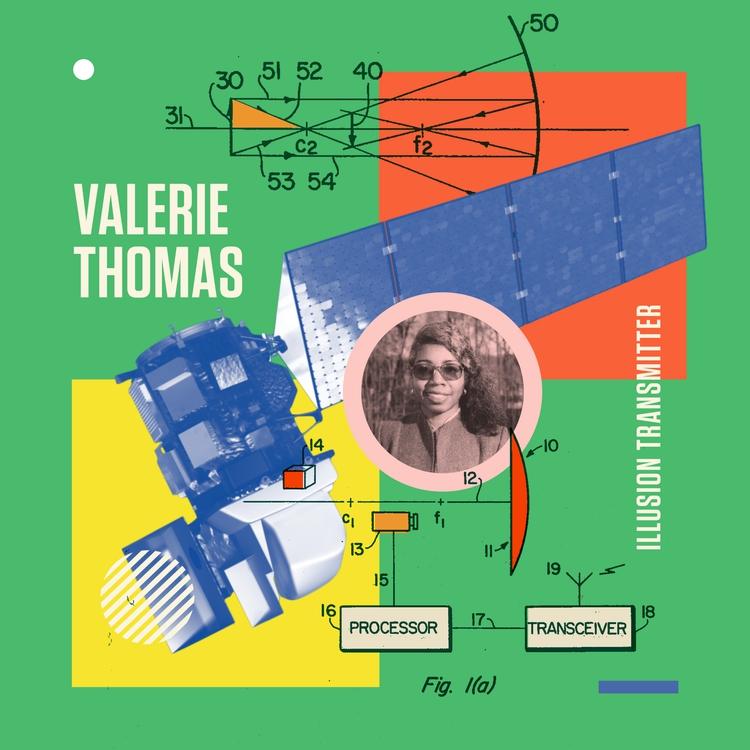
Valerie Thomas is an American scientist and inventor who patented the illusion transmitter in 1980. After seeing an illusion that involved concave mirrors and light bulbs in a museum, she became curious about how she might apply concave mirrors in her work at NASA. Her invention, the illusion transmitter grew out of her experimentation with concave mirrors. You could call it early 3D technology. Her invention transmits an optical illusion of a 3D image between concave mirrors that looks real on the receiving end. NASA continues to use her technology to this day. She also developed real-time computer data systems to support satellite control centers and oversaw the creation of the NASA Landsat program that spearheaded some of the first image transmissions from space.
Ifthere'sonefooditemthatbringseveryone togethermorethanmostduringtheholidays, it'swarm,deliciousdesserts.Fromclassics likepumpkinpiesandcookiestoextravagant disheslikesouffles,lovedonescansavorthe flavorofsweettreatsatthedesserttableall seasonlong.
Thismuch-lovedversionofPumpkinPieisa delicioustakeonatraditionaldessertthat's perfectforanytimeofyear.Evenifyou've neverbakedapie,thiseasyrenditionmakesita cinchtosharewithyournearestanddearest.
It'smadewithGreenGiant100%PurePumpkin, whichismorethanjustaseasonalproduct.You canenjoyitasago-toforsmooth,purepumpkin inbakedgoods,chilis,savorydishesormorning smoothiesasawholesomeboostfullofearthy pumpkinflavor
Oryoucancelebrateitsdeliciousnessinthese coffeehouse-styleBrownButterPumpkinSpice Cookies.Featuringarich,butteryflavor,these pumpkincookiesarerolledincinnamonsugar, bakeupsoftandboastasweet,crunchyexterior that'sperfectforthosewholovepumpkinspice.
Findmoreinspirationforholidaybakingand beyondbyvisiting greengiantvegetables.com.
PumpkinPie
Preptime:15minutes
Cooktime:50-55minutes
Servings:8
1 piecrust(store-boughtorhomemade), atroomtemperature
3 largeeggs
1/2 cupgranulatedsugar
1/3 cuplightbrownsugar
1 can(15ounces)GreenGiant100% PurePumpkin
3/4 cupheavywhippingcream
1 teaspoonvanillaextract
1 teaspoongroundcinnamon
1/2 teaspoongroundginger
1/4 teaspoongroundnutmeg
1/2 teaspoonsalt

Rolloutdoughto2incheslargerthanpiedish.Gentlypressdoughintodish untilitlinesbottomandsides.Trimdoughtowithin1/2inchofdishedge. Foldedgesunderneaththemselves,creatingthick1/4-inchborder.Crimp edgeswithfingers.Refrigerate.Preheatovento375F
Inlargebowl,whiskeggsandsugarsuntilsmooth.Addpumpkin,cream, vanilla,cinnamon,ginger,nutmegandsalt.Stiruntilwellblended.
Slowlypourfillingintopieshell.Coveredgeswiththinstripsofaluminum foil.Bake25minutes.Removefoil.Bake25-30minutes,oruntiltoothpick insertednearcentercomesoutclean.Coolonwirerack.
Brown Butter Pumpkin Spice Cookies
Preptime:30minutes
Cooktime:70minutes
Yield:48-50cookies
1 cupunsaltedbutter
5 cupsall-purposeflour
2 teaspoonsbakingsoda
1 teaspoonsalt
1 tablespoonpumpkin piespice
2 cupsbrownsugar
1 can(15ounces) GreenGiant100% PurePumpkin
1 tablespoonvanilla extract
2 largeeggs 2 eggyolks
ForRolling:
2 tablespoonscanesugar
1 tablespoonbrownsugar
1 teaspooncinnamon

Formdoughintofourseparatelogs2-3inchesin diameterandabout7incheslong.Wrapeachcookie doughlogwithplasticwrap.Freezedough30 minutes,oruntilreadytobake.
Insmallsautepanovermediumheat,meltbutter.Stir regularlyuntilbutterturnsdeepgoldenbrown,8-10 minutes.Pourbrownedbutterintoheat-safebowlor measuringcupandrefrigerateuntilcooled,butnot solid,about15minutes.
Inlargemixingbowl,whiskflour,bakingsoda,salt andpumpkinpiespice.Setaside.
Inseparatemediummixingbowl,stirbrownedbutter andbrownsugar.Whiskinpumpkinandvanilla extractfollowedbyeggsandeggyolks.
Graduallymixwetingredientsintodryuntilevenly mixed.Refrigeratedough30minutes.
Forrolling:Preheatovento350Fandlinelarge bakingsheetwithparchmentpaper.Stirsugarsand cinnamononlargeplate.Unwrapdesiredamountof dough(thawslightlyatroomtemperatureifdoughis completelyfrozen)androlleachloginsugarmixture.
Sliceinto1/2-inchslices.Placeonbakingsheet3 inchesapart.
Bake14-15minutes.Repeatwithremainingcookie dough.
Coolcookiesatroomtemperatureonbakingsheet10 minutesbeforetransferringtocoolingrackand cooling10minutes.




holiday gifts

Snack your way through the season with the DM Snacks 24 Days of Nuts & Snacks. Behind each of the 24 doors lies a single-serve portion of a delectable gourmet nut or snack blend, crafted with premium ingredients and creative seasoning combinations to surprise your tastebuds every day.
A beautiful keepsake holiday dress for your little one this season! Design included hand-stitched smocking, embroidery, and piping along the collar and cuffs, as well as pintucks along the skirt. Sizes 3m - 9m include a matching panty, sizes 12m - 8Y tie in the back with a sash. The perfect holiday outfit - timeless, elegant, and heirloom quality! https://feltmanbrothers.com/girls-floralsmocked-holiday-dress/

This limited-edition 2025 release is a flavorful celebration of savory, sweet, smoky, and spicy sensations. From Cheddar Jalapeño Clusters to WasabiTaproom Mix, Maple Gold Snack Blend to Buffalo Blue Blaze Stix, you’ll discover everything from traditional favorites to adventurous new pairings. Whether you’re into heat (try Honey Inferno Crisps or Spicy Szechuan Peanuts) or prefer a gentler treat like Buttery Bliss Bites, there’s a daily delight for everyone.
Perfect for gifting, this holiday snack countdown is beautifully designed and ready to impress.The sturdy box showcases festive artwork with easy-to-open compartments (no wrapping needed). It
Decodable Readers

makes a great gift for coworkers, friends, foodies, and anyone who loves to snack with variety The individual compartments also make it easy to build charcuterie boards, share with guests, or enjoy mindful portion-controlled bites each day
Only available for the 2025 season, this 24 Days of Nuts & Snacks gift box is a must-have for the holidays. Don’t wait, because once they’re gone, they’re gone! Check it out onAmazon.

A homework book provides extra support with fluency cards, reading pages, and activity sheets. To keep motivation high, an interactive progress chart lets children track their achievements and celebrate milestones in fun, meaningful ways. Prices vary, https://www.readbright.com/backpack/
ReadBright is based on the latest pedagogical research and incorporates decades of practical experience and proven learning techniques. ReadBright provides teachers and educators with fun, colorful, and engaging materials and methods to create competent and fluent readers, and instill in them a lifelong joy and passion for reading.
DM Snacks 24 Days of Nuts & Snacks Advent Calendar

